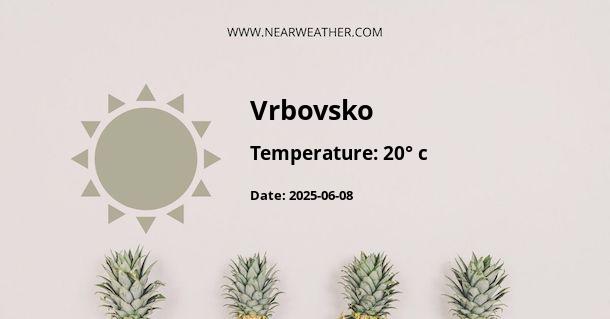Exploring the Climate and Weather of Vrbovsko, Croatia
Nestled within the mountainous region of Gorski Kotar in Croatia, Vrbovsko offers a fascinating climate shaped by its geographic positioning. In this detailed exploration, we delve into the meteorological patterns and characteristics that define the weather in Vrbovsko throughout the year.
Geographical Influence on Vrbovsko's Climate
The town of Vrbovsko is cradled in a valley surrounded by the slopes of the Dinaric Alps. This topography significantly influences the local weather, presenting a mix of Continental and Maritime climate traits. The proximity to the Adriatic Sea and altitude both play a pivotal role in shaping the annual climate profile of this area.
Seasonal Weather Patterns in Vrbovsko
Each season in Vrbovsko brings its unique weather patterns, influenced by the complex interplay between the continental and maritime climates.
- Spring: The season of rejuvenation in Vrbovsko sees a gradual increase in daytime temperatures, with pleasant and sometimes unpredictable weather.
- Summer: Characteristically warm and wet, summer months are prone to thunderstorms due to the combination of heat and moisture funneled from the Adriatic Sea.
- Autumn: Marked by a picturesque change in foliage, autumns are generally cool, with diminishing rainfall towards the late months leading into winter.
- Winter: Snowfall is common in Vrbovsko due to its high elevation and proximity to mountain ranges, offering frosty and at times severe winter conditions.
Temperature and Precipitation Overview
Temperature variances and rainfall distribution play a crucial role in the town's climatic experiences year-round. Utilizing data from meteorological observations, a clearer picture of Vrbovsko's climate emerges. The monthly average temperatures range from a low of -3°C in the coldest months to a high of 20°C during the summer peak. Annual precipitation levels average around 1,500 mm, making Vrbovsko one of the wetter regions in Croatia.
Table: Average Monthly Temperatures and Precipitation in Vrbovsko
| Month | Average High (°C) | Average Low (°C) | Precipitation (mm) |
|---|---|---|---|
| January | 2 | -3 | 137 |
| February | 4 | -2 | 118 |
| March | 9 | 1 | 110 |
| April | 14 | 5 | 133 |
| May | 19 | 10 | 128 |
| June | 22 | 13 | 137 |
| July | 25 | 16 | 110 |
| August | 24 | 15 | 122 |
| September | 20 | 11 | 135 |
| October | 14 | 7 | 148 |
| November | 8 | 3 | 178 |
| December | 3 | -1 | 163 |
Microclimates and Local Weather Anomalies
Occasionally, Vrbovsko faces weather anomalies caused by microclimates resulting from its varied topography. Valley inversions can lead to pockets of colder air being trapped, causing significant temperature differences over a short distance. Such occurrences illustrate the localized nature of the town's weather systems.
Extreme Weather Conditions and Trends
Extreme weather events, such as heavy snowfall and severe storms, although not frequent, can occur, particularly in the transitional months where dynamic shifts in seasonal patterns are present.
Climatologists and meteorologists often utilize statistical models and historical data to monitor and understand shifts in extreme weather patterns. While Vrbovsko's historical record reflects stability in its climate trends, recent observations indicate subtle changes, likely linked to broader climatic shifts occurring globally.
Snowfall and Winter Conditions
Vrbovsko's winters are characterized by snowfall which can impact daily life and travel. The following outlines snowfall statistics and how the winter weather affects the region:
- Average snowfall depth during peak winter months can vary but typically ranges from 30 to 100 cm.
- Occasionally, heavy snowstorms result in snow depths exceeding the average by a considerable margin, disrupting transport and infrastructure.
- Preparations for winter conditions include snow-clearing operations and the distribution of road salt to manage ice build-up.
Sunshine and Daylight Hours
Daylight hours and sunshine also influence Vrbovsko's weather, where shorter days in winter and longer days in summer shape activities and energy consumption patterns. On average, Vrbovsko enjoys a moderate amount of sunshine, with an uptick during the summer months.
Wind Patterns
Winds in Vrbovsko, such as the Bora, a northeasterly wind, can cause sudden drops in temperature and challenging weather conditions, particularly during winter months.
Adapting to Climate Variability
Residents and local authorities in Vrbovsko are accustomed to the climate variability, planning agricultural practices, tourism, and infrastructure development around the seasonal weather patterns. Pre-emptive weather forecasting and advisories aid in preparing for potential extreme weather occurrences.
Conclusion
In conclusion, Vrbovsko's climate is emblematic of the broader climate dynamics of the Gorski Kotar region. Its weather patterns encapsulate the interplay between the influences of the Dinaric Alps and Adriatic Sea proximity, resulting in a diverse and sometimes challenging climate. Understanding these patterns is crucial for the local economy, agriculture, and day-to-day living. With careful analysis and thoughtful adaptation strategies, the people of Vrbovsko continue to thrive in this beautiful, yet sometimes unpredictable climate.
A - Vrbovsko's Latitude is 45.368610 & Longitude is 15.078330.
A - Weather in Vrbovsko is 28° today.
A - Climate Conditions in Vrbovsko shows clear sky today.
A - Humidity in Vrbovsko is 32% today.
A - Wind speed in Vrbovsko is 9.72 km/h, flowing at 88° wind direction. today.
